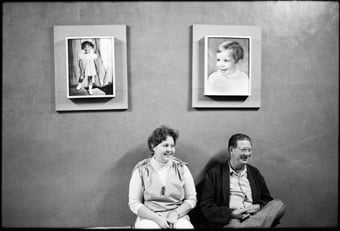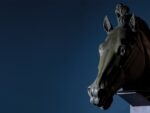Ana Mendieta / Martha Rosler

Proseguendo la serie di doppie personali, la Galleria Cortese è orgogliosa di presentare le mostre di Ana Mendieta (nello spazio di via Stradella 7) e di Martha Rosler (in via Stradella 1).
Comunicato stampa
Proseguendo la serie di doppie personali, la Galleria Cortese è orgogliosa di presentare le mostre di Ana Mendieta (nello spazio di via Stradella 7) e di Martha Rosler (in via Stradella 1).
Due mostre di due artiste, punti di riferimento nella storia dell'arte, che con diverso approccio hanno indagato tematiche quali il femminismo e l'appartenenza sociale e culturale e le relative contraddizioni, attraverso il mezzo fotografico e video.
Raffaella Cortese is pleased to present two solo shows by Ana Mendieta (in the space of via Stradella 7) and Martha Rosler (in via Stradella 1), which continue the series of double solo exhibitions started some years ago. Two shows dedicated to two artists who marked the recent history of art, by investigating through photos and videos, with different approaches, issues like feminism, social and cultural belonging and the related contradictions.
Ana Mendieta
Ana Mendieta, Silueta de Cohetes, 1976
Esule cubana, compie gli studi artistici presso lIowa State Univeristy negli Stati Uniti dove viene a contatto con il movimento delle donne e abbraccia gli ideali del femminismo. Mendieta fa una propria sintesi della Body Art e della Land Art sovvertendo i gesti monumentali dei land-artisti attraverso l'inserimento nel paesaggio del corpo umano. In quegli anni inizia a realizzare performance rituali, fotografie e sculture, in cui immerge il suo corpo nella natura, partendo da un legame spirituale e fisico con la Terra.
In mostra i suoi primi lavori fotografici degli anni 70 dove si confronta con la discriminazione, la violenza carnale e la morte. Dopo aver letto dello stupro e dell'assassino di una studentessa nel suo stesso campus universitario, Mendieta reagisce mettendo in scena il brutale episodio usando il proprio corpo: "Sto lavorando con il mio sangue e il mio corpo", afferma lartista. Nascono così i famosi lavori Untitled (Rape Performance), 1973 e Sweating Blood, 1973.
L'artista prende a prestito simboli e aspetti di pratiche rituali di antiche culture indigene delle Americhe, Africa ed Europa e vi incorpora elementi della natura e di riti sacrificali "primitivi" associati alla "santeria cubana". Nella serie di opere "Siluetas", forme che evocano il suo corpo, usa sangue, acqua, terra e fuoco. Le sagome vengono bruciate nel legno, modellate con tumuli di terra, erba, polvere da sparo o fiori; galleggiano sulla corrente, eruttano come vulcani o si mimetizzano con il paesaggio, come si percepisce dai video in mostra. Mendieta ha saputo esprimere con larte «limmediatezza della vita e leternità della natura».
E' attualmente in corso un'importante retrospettiva dell'artista al Castello di Rivoli, Torino.
Ana Mendieta (LHavana, Cuba, 1948, New York 1985).
Tra le principali mostre personali dedicate allartista cubano-americana ricordiamo nel 2004 la mostra itinerante Ana Mendieta: Earth Body, Sculpture and Performance 1972-1985, Whitney Museum of American Art, New York; Hirshhorn Museum and Sculpture Garden, Smithsonian Institution, Washington D.C.; Des Moines Art Center, Des Moines e Miami Art Museum, Miami; nel 2002 Ana Mendieta (1948-1985) Body Tracks, Neues Museum Luzern, Lucerna e Fries Museum, Leeuwarden; Ana Mendieta Selected Works, Kunst-Werke Berlin KW Institute of Contemporary Art, Berlino; nel 1996 Ana Mendieta (19481985), Helsinki City Art Museum, Helsinki; Uppsala Konstmuseum, Uppsala; The Living Art Museum, Reykjavik e Museum of Contemporary Art, Roskilde; Ana Mendieta, Centro Galego de Arte Contemporanea, Santiago de Compostela; Kusthalle Düsseldorf, Düsseldorf; Fundació Antoni Tápies, Barcellona; Museo de Arte Contemporaneo de Monterrey, Monterrey e Museo Tamayo, Città del Messico; nel 1994 Ana Mendieta: The Late Works, Cleveland Center for Contemporary Art, Cleveland e Artothèque de Caen, Caen.; She got Love, Castello di Rivoli.
Cuban exile, Mendieta studies at Iowa State University, where she comes in contact with feminist movements and embraces the ideals of feminism. She realizes a personal synthesis of Body Art and Land Art, by undermining Land-artists majestic actions through the introduction of the human body in the landscape. In those years, she realizes ritual performances, photographs and sculptures, steeping her own body into nature, thus emphasizing her physical and spiritual link with the Earth. On show, her first works from the Seventies, where she confronts herself with the themes of discrimination, sexual violence and death. After reading about the rape and murder of a girl attending her university campus, Mendieta puts up the brutal event using her own body: Im working with my body and my blood, she declares. (Untitled (Rape Performance), 1973 and Sweating Blood, 1973).
Mendieta borrows symbols and ritual practices from American, African and European native cultures, combining them with natural elements and primitive sacrificial rites, associated to the santeria cubana. In the "Siluetas" series, she uses blood, water, earth and fire to build up shapes which remember her own body. The silhouettes are burned on wood, shaped by mounds of earth, grass, gun powder or flowers; they float on streams, erupt like volcanos or blend in with the landscape, as shown in the exhibited videos. Mendieta has expressed with her work the immediacy of life and the eternity of nature.
Currently on show, an important retrospective of her work at Castello di Rivoli, Turin.
Ana Mendieta (LHavana, Cuba, 1948, New York 1985).
Among the major solo shows dedicated to the Cuban-American artist, we mention: the travelling exhibition Ana Mendieta: Earth Body, Sculpture and Performance 1972-1985, Whitney Museum of American Art, New York; Hirshhorn Museum and Sculpture Garden, Smithsonian Institution, Washington D.C.; Des Moines Art Center, Des Moines and Miami Art Museum, Miami (2004); in 2002 Ana Mendieta (1948-1985) Body Tracks, Neues Museum Luzern, Lucerne and Fries Museum, Leeuwarden; Ana Mendieta Selected Works, Kunst-Werke Berlin KW Institute of Contemporary Art, Berlin; in 1996 Ana Mendieta (19481985), Helsinki City Art Museum, Helsinki; Uppsala Konstmuseum, Uppsala; The Living Art Museum, Reykjavik and Museum of Contemporary Art, Roskilde; Ana Mendieta, Centro Galego de Arte Contemporanea, Santiago de Compostela; Kusthalle Düsseldorf, Düsseldorf; Fundació Antoni Tápies, Barcellona; Museo de Arte Contemporaneo de Monterrey, Monterrey and Museo Tamayo, Mexico City; in 1994 Ana Mendieta: The Late Works, Cleveland Center for Contemporary Art, Cleveland and Artothèque de Caen, Caen; She got Love, Castello di Rivoli (2013).
Martha Rosler
CUBA, JANUARY 1981
Martha Rosler, Photo shop, Havana, from the Cuba series, 1981
Il solo show Cuba, January 1981 di Martha Rosler presenta fotografie inedite in Europa, a colori e in bianco e nero, inclusi dei dittici. Nel 1981, Martha Rosler e un gruppo di altre artiste ed intellettuali, parteciparono a un viaggio culturale organizzato da Ana Mendieta e Lucy Lippard. Attraversando l'isola, Rosler fotografò persone, negozi, edifici e i manifesti e cartelloni, che costellavano le strade e gli spazi pubblici. Così l'artista ha ricordato quel periodo:
"Il mese di gennaio del 1981 segnò la fine degli anni Settanta, non solo per ovvie ragioni, ma segnò anche il momento successivo all'elezione di Reagan e ai discorsi riguardanti il disgelo, i diritti umani e l'uguaglianza, e precedente all'insediamento del presidente, alla carica di neoliberalismo, anti-terrorismo e avventurismo militarista, e all'affermarsi della retorica economica dell'offerta con effetto a cascata, mascherando l'enorme ridistribuzione della ricchezza verso l'alto.
Il fenomeno migratorio da Cuba verso la Florida, noto come The Mariel boatlift, era terminato in ottobre, appena in tempo per l'elezione di Reagan nel mese di novembre. Ma ciò che hanno significato gli anni Ottanta, per noi e per i cubani che incontravamo, non si era ancora concretizzato, e rimaneva relegato nei nostri incubi e nelle nostre paure."
Inquadrata cronologicamente tra la celebre opera di Rosler The Bowery in two inadequate descriptive systems (1974/75), composta di fotografie e testi, e il suo saggio In around and afterthoughts (on documentary photography) (1981), questa serie si colloca accanto alle fotografie di aeroporti, strade, vetrine e trasporti pubblici che caratterizzeranno tutta la sua carriera.
Le immagini rappresentano un'esperienza visiva degli spazi comuni della società, luoghi dove il mondo esteriore ed interiore si incontrano: caffé, scuole, saloni di bellezza, teatri, chiese. Poiché Cuba, all'epoca era quasi inavvicinabile per i cittadini americani - e lo è tuttora - queste fotografie si inseriscono in una nebulosa di congetture ampiamente contrastanti sulla cultura cubana e sul ruolo del comunismo cubano.
Martha Rosler è nata a Brooklyn, New York, dove vive e lavora.
Diversi musei europei e americani le hanno dedicato importanti retrospettive, come quelle al New Museum di New York e all'International Center of Photography, tra il 1998 e il 2000, e alla GAM di Torino nel 2010. I suoi fotomontaggi sono stati esposti al Worcester Art Museum in Massachusetts nel 2007.
I suoi scritti sono stati pubblicati su riviste e cataloghi, e i suoi 17 libri, con fotografie, testi e narrazioni, tradotti in molte lingue. Decoys and Disruptions: Selected Writings, 1975-2001, un libro di saggi della Rosler, è stato pubblicato dlla MIT Press nel 2004 (e ristampato nel 2008). Altri progetti includono le itineranti Martha Rosler Library, comprendente 8.000 volumi della sua collezione, e If You Lived Here Still, entrambi realizzate in collaborazioni con e-flux. Recentemente, il Museum of Modern Art di New York` ha ospitato la sua mostra e performance Meta- Monumental Garage Sale (2012).
The exhibition Cuba, January 1981 by Martha Rosler presents color and black and white photographs, including several diptychs, that have not previously been exhibited in Europe.
In early 1981, Rosler and a group of other artists and intellectuals joined a cultural tour organized by Ana Mendieta and Lucy Lippard. Traveling around the island, Rosler photographed shops, buildings, and people as well as the posters and billboards that punctuated the roads and urban spaces. About the period during which the images were taken, Rosler has commented:
"January 1981 marked the end of the 1970s, not only for the obvious reason but because it marked the moment after Reagans election and before his inauguration, after the discourses of détente, human rights, and egalitarianism and before the onslaught of neoliberalism, anti-terrorism and militarist adventurism and supply-side trickle-down rhetoric masking the huge upward redistribution of wealth. The Mariel boatlift from Cuba to Florida had just ended in October, just in time for Reagans election in November. But the meaning of the 80s for us as well as for the Cubans we met was still located only in our nightmares and fears, not yet realized."
Bracketed chronologically by Roslers well-known photo-text work The Bowery in two inadequate descriptive systems (1974/75) and her highly influential essay, "In, around and afterthoughts (on documentary photography)" (1981), this series takes its place alongside Roslers photographs of airports, roads, shop windows, and public transportation as part of a career-long photographic practice.
The images, like Roslers other photographic images, present a visual experience of the common spaces of society and the spaces where exterior and interior worlds intersect: cafes, schools, beauty parlors, theathers, churches. As Cuba was, at the time - and it still remains - largely off limits to U.S. citizens, these images also exist in a hazy area of widely divergent assumptions about Cuban culture and the role of Cuban Communism.
Martha Rosler was born in Brooklyn, New York, where she lives and works.
Rosler's retrospective was shown in several European cities and in New York at the New Museum and the International Center of Photography between 1998 and 2000. A solo exhibition of her war photomontages was held at the Worcester Art Museum in Massachusetts in 2007. In 2010 a retrospective exhibition of her work was shown at GAM in Turin. Her writing has been published widely in magazines and catalogues, and she has published 17 books, in several languages, with photographs, texts, and commentary. Decoys and Disruptions: Selected Writings, 1975-2001, a book of Rosler's essays, was published by the MIT Press in 2004 (reprinted, 2008). Other projects include the traveling exhibitions Martha Rosler Library, comprising 8,000 volumes from Rosler's collection, and If You Lived Here Still, both in collaboration with e-flux. Most recently her solo exhibition and performance, Meta-Monumental Garage Sale, was held at the Museum of Modern Art in New York in 2012.



